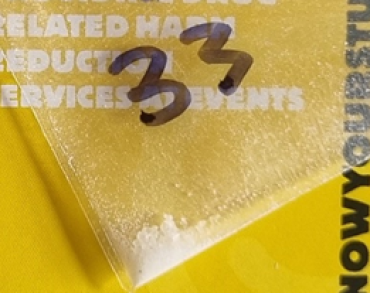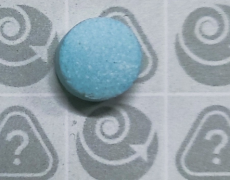Increase in ketamine analogues found in New Zealand


Over the last six months, we've noticed an increase in ketamine analogues present in the New Zealand drug environment. Here’s what you need to know.
Ketamine analogues are a group of drugs synthesised to be similar to the dissociative ketamine. Ketamine is a sedative drug, or dissociative anaesthetic. That means people who take ketamine can experience a sense of detachment from their body and surroundings. Ketamine is sometimes described as a psychedelic, and some companies are using ketamine as an anti-depressant. Two analogues recently detected in New Zealand include fluorexetamine (FXE) and 2-Fluorodeschloroketamine (2-FDCK), both of which have been detected at drug checking services.
Stay safer by staying informed. Sign up to receive alerts and notifications about any dangerous drugs in NZ. Check out the alerts page to see what we've already found.
What’s going on with ketamine analogues?
While ketamine analogues are not as commonly available as ketamine, a number of commenters on online drug forums have expressed interest in trying these substances as an alternative to, or graduation from, ketamine. Based on international trends, it’s possible analogues will continue to be present, and possibly increase, in New Zealand.
This poses a risk as it could lead to increased misrepresentation which can lead to serious harm. This has already happened in New Zealand – KnowYourStuffNZ has seen substances thought to be something else actually turn out to contain ketamine analogues. It has also been seen overseas – Australian drug checking services have reported a number of cases where ketamine analogues were misrepresented as other substances.
Sample of presumed ketamine that Know Your Stuff NZ found to contain fluorexetamine and no ketamine
Remember, there’s no way to know if a substance is actually what you think it is, unless you get it checked. You can’t just take someone’s word that you have what you think you have, and you can’t just go on sight or smell alone. Drug checking is free, legal, and confidential. You can find information about upcoming drug checking clinics here thanks to our mates at The Level.
What are the effects of ketamine compared with its analogues?
The desired effects of ketamine analogues are similar to ketamine and include sensory detachment, sensations of floating or feeling separated from your body, and in high doses a ‘K Hole’, a state of unresponsiveness with vivid hallucinations – read more about it here.
Ketamine has been used and studied extensively in medicine since it was first synthesised in the 1960’s, with the effects and risks being relatively well understood.
Analogues such as FXE and 2-FDCK are new and have not been researched clinically. They may carry unique risks and effects that we are not yet aware of and may require different dosages.
For example, while FXE is reported to produce a similar baseline of effects to that of ketamine, people who have taken it also report feeling more confident and manic while under its effects. It may appear as less sedating than ketamine, but this does not mean it is any less potent.
Meanwhile, 2-FDCK supposedly shares more similarities with ketamine than FXE, but there’s a longer period of hallucinogenic sensations, and potentially needs a slightly higher dose.
There has been very little research into the long-term effects of ketamine analogues, but long-term effects of chronic ketamine use can include bladder problems, memory impairments, and reduced psychological wellbeing. It’s not known whether these ketamine analogues share similar long-term effects.
Steps that can help reduce the risk of harm
Remember, although similar, ketamine and its analogues can vary significantly both in terms of effects and potency.
If you choose to use these substances:
- Start low, go slow. Take a small dose and wait to see how it affects you. The ‘K Hole’ can be a very disturbing experience, especially if it wasn’t the intended effect.
- If you start feeling unwell or sick, don’t take any more of the substance.
- Avoid redosing. Ketamine has a cumulative effect, and it is easy to push it too far.
- Avoid mixing drugs as the combined effects can be unpredictable and increase risk. Especially avoid mixing ketamine or ketamine analogues with depressants like alcohol, benzos, and opiates. The combined sedative effect increases the risk of choking, overdose or losing consciousness.
- Try to use in a safe and calm environment, as the effects may be overwhelming in busy backgrounds.
- Don’t use alone. It’s better to have people around that you trust and who have knowledge of first aid.
What to do in an emergency
If you think someone is suffering from an overdose:
- Call 111 immediately and ask for an ambulance.
- Don’t panic. Stay calm.
- Keep yourself safe. Watch out for used needles and blood on the bed or floor etc.
- Check if the person is conscious by gently shaking them and calling their name or asking if they’re ok. This may bring the person round.
- If the person does not respond, check whether they are breathing.
- Check their airway. Tilt their head back enough to open their airway. Remove anything from their mouth like food or vomit.
- Are they breathing? Put you ear next to their mouth. Can you feel any breath? Is their chest rising?
- If they are breathing put them in the recovery position.
- If they are not breathing start CPR.
Check out St John’s first aid guide for dealing with an overdose.
If you have any concerns about your own drinking or drug taking, get in touch with the Alcohol Drug Helpline Call 0800 787 797, or text 8681, to speak with a trained counsellor – they’ll be able to provide you with helpful information, insight and support. They’re available 24/7, all calls are free and confidential.
Latest Alerts & Notifications

Synthetic Cannabinoid misrepresented as DMT

Highly potent synthetic opioid detected in fake diazepam tablet

Alpha-PVP like substance misrepresented as MDMA in Christchurch

Heroin sold as ketamine in Auckland region

Latest News

26 Apr 2024
Overdosing on opioids

24 Apr 2024
Increased harm linked to the use of GBL-type substances in New Zealand

23 Apr 2024
Industrial chemicals sold as methamphetamine

15 Apr 2024
Thinking of using GBL/GHB?

12 Apr 2024
Ketamine and bladder damage – know the risks

8 Mar 2024
Synthetic cathinones explained

22 Feb 2024
What’s happening with synthetic cannabinoids?

31 Jan 2024
What is tuci?

19 Jan 2024
Answering some common questions about MDMA

10 Jan 2024
Understanding the risks of the comedown
